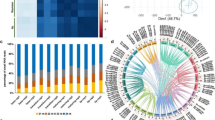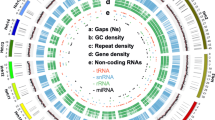Abstract
The entomopathogenic fungus Metarhizium anisopliae is widely used for biological control of a variety of insect pests. The effectiveness of the microbial pest control agent, however, is limited by poor thermotolerance. The molecular mechanism underlying the response to heat stress in the conidia of entomopathogenic fungi remains unclear. Here, we conducted high-throughput RNA-Seq to analyze the differential gene expression between control and heat treated conidia of M. anisopliae at the transcriptome level. RNA-Seq analysis generated 6,284,262 and 5,826,934 clean reads in the control and heat treated groups, respectively. A total of 2,722 up-regulated and 788 down-regulated genes, with a cutoff of twofold change, were identified by expression analysis. Among these differentially expressed genes, many were related to metabolic processes, biological regulation, cellular processes and response to stimuli. The majority of genes involved in endocytic pathways, proteosome pathways and regulation of autophagy were up-regulated, while most genes involved in the ribosome pathway were down-regulated. These results suggest that these differentially expressed genes may be involved in the heat stress response in conidia. As expected, significant changes in expression levels of genes encoding heat shock proteins and proteins involved in trehalose accumulation were observed in conditions of heat stress. These results expand our understanding of the molecular mechanisms of the heat stress response of conidia and provide a foundation for future investigations.




Similar content being viewed by others

References
Adams J (2003) The proteasome: structure, function, and role in the cell. Cancer Treat Rev 29:3–9
Al-Bader N, Vanier G, Liu H, Gravelat FN, Urb M, Hoareau CMQ, Campoli P, Chabot J, Filler SG, Sheppard DC (2010) Role of trehalose biosynthesis in Aspergillus fumigatus development, stress response, and virulence. Infect Immun 78:3007–3018
Albrecht D, Guthke R, Brakhage AA, Kniemeyer O (2010) Integrative analysis of the heat shock response in Aspergillus fumigatus. BMC Genomics 11:32
Audic S, Claverie JM (1997) The significance of digital gene expression profiles. Genome Res 7:986–995
Barros BHR, Silva SH, Marques EDR, Rosa JC, Yatsuda AP, Roberts DW, Braga GUL (2010) A proteomic approach to identifying proteins differentially expressed in conidia and mycelium of the entomopathogenic fungus Metarhizium acridum. Fungal Biol 114:572–579
Cherkasov V, Hofmann S, Druffel-Augustin S, Mogk A, Tyedmers J, Stoecklin G, Bukau B (2013) Coordination of translational control and protein homeostasis during severe heat stress. Curr Biol 23:2452–2462
Doehlemann G, Berndt P, Hahn M (2006) Trehalose metabolism is important for heat stress tolerance and spore germination of Botrytis cinerea. Microbiol SGM 152:2625–2634
Duan Z, Chen Y, Huang W, Shang Y, Chen P, Wang C (2013) Linkage of autophagy to fungal development, lipid storage and virulence in Metarhizium robertsii. Autophagy 9:538–549
Fang W, Bidochka MJ (2006) Expression of genes involved in germination, conidiogenesis and pathogenesis in Metarhizium anisopliae using quantitative real-time RT-PCR. Mycol Res 110:1165–1171
Fernandes EKK, Bittencourt VREP, Roberts DW (2012) Perspectives on the potential of entomopathogenic fungi in biological control of ticks. Exp Parasitol 130:300–305
Frazzon APG, Vaz ID, Masuda A, Schrank A, Vainstein MH (2000) In vitro assessment of Metarhizium anisopliae isolates to control the cattle tick Boophilus microplus. Vet Parasitol 94:117–125
Gao QA, Jin K, Ying SH, Zhang YJ, Xiao GH, Shang YF, Duan ZB, Hu XA, Xie XQ, Zhou G, Peng GX, Luo ZB, Huang W, Wang B, Fang WG, Wang SB, Zhong Y, Ma LJ, St Leger RJ, Zhao GP, Pei Y, Feng MG, Xia YX, Wang CS (2011) Genome sequencing and comparative transcriptomics of the model entomopathogenic fungi Metarhizium anisopliae and M. acridum. PLoS Genet 7:e1001264
Gokce E, Franck WL, Oh Y, Dean RA, Muddiman DC (2012) In-depth analysis of the Magnaporthe oryzae conidial proteome. J Proteome Res 11:5827–5835
Kanehisa M, Araki M, Goto S, Hattori M, Hirakawa M, Itoh M, Katayama T, Kawashima S, Okuda S, Tokimatsu T, Yamanishi Y (2008) KEGG for linking genomes to life and the environment. Nucleic Acids Res 36:D480–D484
Kim JS, Kassa A, Skinner M, Hata T, Parker BL (2011) Production of thermotolerant entomopathogenic fungal conidia on millet grain. J Ind Microbiol Biotechnol 38:697–704
Korolchuk VI, Menzies FM, Rubinsztein DC (2009) A novel link between autophagy and the ubiquitin–proteasome system. Autophagy 5:862–863
Kultz D (2005) Molecular and evolutionary basis of the cellular stress response. Annu Rev Physiol 67:225–257
Lamarre C, Sokol S, Debeaupuis JP, Henry C, Lacroix C, Glaser P, Coppée JY, Francois JM, Latgé JP (2008) Transcriptomic analysis of the exit from dormancy of Aspergillus fumigatus conidia. BMC Genomics 9:417
Leng Y, Peng G, Cao Y, Xia Y (2011) Genetically altering the expression of neutral trehalase gene affects conidiospore thermotolerance of the entomopathogenic fungus Metarhizium acridum. BMC Microbiol 11:32
Li R, Yu C, Li Y, Lam TW, Yiu SM, Kristiansen K, Wang J (2009) SOAP2: an improved ultrafast tool for short read alignment. Bioinformatics 25:1966–1967
Li Z, Zhang Z, Yan P, Huang S, Fei Z, Lin K (2011) RNA-Seq improves annotation of protein-coding genes in the cucumber genome. BMC Genomics 12:540
Liang WD, Bi YT, Wang HY, Dong S, Li KS, Li JS (2013) Gene expression profiling of Clostridium botulinum under heat shock stress. Biomed Res Int:760904
Liao X, Lu HL, Fang W, St Leger RJ (2013) Overexpression of a Metarhizium robertsii HSP25 gene increases thermotolerance and survival in soil. Appl Microbiol Biotechnol 98:777–783
Lin JQ, Zhao XX, Zhi QQ, Zhao M, He ZM (2013) Transcriptomic profiling of Aspergillus flavus in response to 5-azacytidine. Fungal Genet Biol 56:78–86
Livak KJ, Schmittgen TD (2001) Analysis of relative gene expression data using real-time quantitative PCR and the 2−ΔΔC T method. Methods 25:402–408
Lord JC (2005) From Metchnikoff to Monsanto and beyond: the path of microbial control. J Invertebr Pathol 89:19–29
Marsh M, McMahon HT (1999) The structural era of endocytosis. Science 285:215–220
McMahon HT, Boucrot E (2011) Molecular mechanism and physiological functions of clathrin-mediated endocytosis. Nat Rev Mol Cell Biol 12:517–533
Miaczynska M, Stenmark H (2008) Mechanisms and functions of endocytosis. J Cell Biol 180:7–11
Montero-Barrientos M, Cardoza RE, Gutierrez S, Monte E, Hermosa R (2007) The heterologous overexpression of hsp23, a small heat-shock protein gene from Trichoderma virens, confers thermotolerance to T. harzianum. Curr Genet 52:45–53
Mortazavi A, Williams BA, McCue K, Schaeffer L, Wold B (2008) Mapping and quantifying mammalian transcriptomes by RNA-Seq. Nat Methods 5:621–628
Nitsche BM, Burggraaf-van Welzen AM, Lamers G, Meyer V, Ram AFJ (2013) Autophagy promotes survival in aging submerged cultures of the filamentous fungus Aspergillus niger. Appl Microbiol Biotechnol 97:8205–8218
Nookaew I, Papini M, Pornputtapong N, Scalcinati G, Fagerberg L, Uhlen M, Nielsen J (2012) A comprehensive comparison of RNA-Seq-based transcriptome analysis from reads to differential gene expression and cross-comparison with microarrays: a case study in Saccharomyces cerevisiae. Nucleic Acids Res 40:10084–10097
Oshlack A, Robinson MD, Young MD (2010) From RNA-Seq reads to differential expression results. Genome Biol 11:220
Parsell DA, Lindquist S (1993) The function of heat-shock proteins in stress tolerance: degradation and reactivation of damaged proteins. Annu Rev Genet 27:437–496
Plesofsky-Vig N, Brambl R (1985) Heat shock response of Neurospora crassa: protein synthesis and induced thermotolerance. J Bacteriol 162:1083–1091
Pollack JK, Harris SD, Marten MR (2009) Autophagy in filamentous fungi. Fungal Genet Biol 46:1–8
Rangel DEN, Butler MJ, Torabinejad J, Anderson AJ, Braga GUL, Day AW, Roberts DW (2006) Mutants and isolates of Metarhizium anisopliae are diverse in their relationships between conidial pigmentation and stress tolerance. J Invertebr Pathol 93:170–182
Rangel DEN, Alston DG, Roberts DW (2008) Effects of physical and nutritional stress conditions during mycelial growth on conidial germination speed, adhesion to host cuticle, and virulence of Metarhizium anisopliae, an entomopathogenic fungus. Mycol Res 112:1355–1361
Ries L, Pullan ST, Delmas S, Malla S, Blythe MJ, Archer DB (2013) Genome-wide transcriptional response of Trichoderma reesei to lignocellulose using RNA sequencing and comparison with Aspergillus niger. BMC Genomics 14:541
Rokas A, Gibbons JG, Zhou X, Beauvais A, Latgé JP (2012) The diverse applications of RNA-Seq for functional genomic studies in Aspergillus fumigatus. Ann N Y Acad Sci 1273:25–34
Ruoff P, Vinsjevik M, Mohsenzadeh S, Rensing L (1999) The Goodwin model: simulating the effect of cycloheximide and heat shock on the sporulation rhythm of Neurospora crassa. J Theor Biol 196:483–494
Ryter SW, Choi AM (2013) Autophagy: an integral component of the mammalian stress response. J Biochem Pharmacol Res 1:176–188
Shang F, Taylor A (2011) Ubiquitin–proteasome pathway and cellular responses to oxidative stress. Free Radic Biol Med 51:5–16
Soanes DM, Chakrabarti A, Paszkiewicz KH, Dawe AL, Talbot NJ (2012) Genome-wide transcriptional profiling of appressorium development by the rice blast fungus Magnaporthe oryzae. PLoS Pathog 8:e1003604
St Leger RJ, Wang C (2010) Genetic engineering of fungal biocontrol agents to achieve greater efficacy against insect pests. Appl Microbiol Biotechnol 85:901–907
Su Y, Guo Q, Tu J, Li X, Meng L, Cao L, Dong D, Qiu J, Guan X (2013) Proteins differentially expressed in conidia and mycelia of the entomopathogenic fungus Metarhizium anisopliae sensu stricto. Can J Microbiol 59:443–448
Voigt O, Pöggeler S (2013) Self-eating to grow and kill: autophagy in filamentous ascomycetes. Appl Microbiol Biotechnol 97:9277–9290
Walstad JD, Anderson RF, Stambaugh WJ (1970) Effects of environmental conditions on two species of muscardine fungi (Beauveria bassiana and Metarhizium anisopliae). J Invertebr Pathol 16:221–226
Wang Z, Gerstein M, Snyder M (2009) RNA-Seq: a revolutionary tool for transcriptomics. Nat Rev Genet 10:57–63
Ye J, Fang L, Zheng H, Zhang Y, Chen J, Zhang Z, Wang J, Li S, Li R, Bolund L, Wang J (2006) WEGO: a web tool for plotting GO annotations. Nucleic Acids Res 34:W293–W297
Ying SH, Feng MG (2011) A conidial protein (CP15) of Beauveria bassiana contributes to the conidial tolerance of the entomopathogenic fungus to thermal and oxidative stresses. Appl Microbiol Biotechnol 90:1711–1720
Zhang S, Xia Y, Keyhani NO (2011) Contribution of the gas1 gene of the entomopathogenic fungus Beauveria bassiana, encoding a putative glycosylphosphatidylinositol-anchored β-1,3-glucanosyltransferase, to conidial thermotolerance and virulence. Appl Environ Microbiol 77:2676–2684
Acknowledgments
This work was supported by the Special Fund for Forestry Scientific Research in the Public Interest (Grant No. 201204506), the National Natural Science Foundation of China (Grant Nos. 31201568 and 31272096) and the Key Project for Natural Science Research of Anhui Provincial Higher School (Grant No. KJ2014A012).
Author information
Authors and Affiliations
Corresponding author
Additional information
Zhang-Xun Wang and Xia-Zhi Zhou contributed equally to this work.
Rights and permissions
About this article
Cite this article
Wang, ZX., Zhou, XZ., Meng, HM. et al. Comparative transcriptomic analysis of the heat stress response in the filamentous fungus Metarhizium anisopliae using RNA-Seq. Appl Microbiol Biotechnol 98, 5589–5597 (2014). https://doi.org/10.1007/s00253-014-5763-y
Received:
Revised:
Accepted:
Published:
Issue Date:
DOI: https://doi.org/10.1007/s00253-014-5763-y



